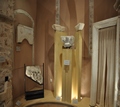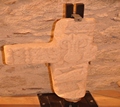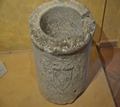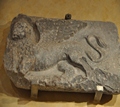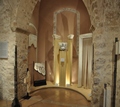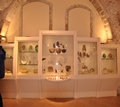
The Archaeological Collection of Monemvasia is housed in a historic preserved building with many building phases: it was built as a Mosque in the Turkish period (16th century), converted into a public building in the Second Venetian period (1690-1713) and functioned as a prison and cafe after the Liberation.
The Archaeological Collection of Monemvasia has rich material on the identity of the "peronymous homeless person" of Monemvasia, whose presence on the rocky edge of the Peloponnese is attested from the 6th AD. century.
The Collection was inaugurated in 1999.
The current position of Monemvasia on the sea routes, its fleet which dominated the main ports of the Mediterranean and also those of the Black Sea, its famous products (such as the excellent Malvasia wine), the members of its society who distinguished themselves in trade, in the arts and in a multitude of spiritual activities, its local church that highlighted important personalities, but also the favor granted to it with imperial chrysobulls, forged its prestige and reputation.
Inside the open museum space of the city of Monemvasia, its surviving monuments (fortress, walls, important temples, houses, public buildings, hammams, cisterns), are evidence of its past and vividly narrate its historical journey.
The permanent exhibition was organized to present to the general public archaeological finds that resulted from collections and excavations in the area of Monemvasia. The exhibits are historical testimonies of human activity and the artistic life that developed in Monemvasia, from the early Christian years to the late Turkish rule, but also indicate the communication of Monemvasia, commercial and cultural, with other regions.
The aim of the exhibition is to provide evidence on the one hand about public life, through the thematic unity of the sculptures of the built environment, and on the other hand, about private or individual life, through objects of ceramics and micro-arts. The exhibition is primarily educational as well as informative and the exhibits are accompanied, in addition to their signs, by corresponding bilingual explanatory texts. The suggested route for the visitor starts from the north interior face of the building, with a group of outdoor sculptures: the coats of arms, a western custom introduced during the Frankish period (a relief with the Venetian lion, a plaque from 1525 with a shield in relief) and the sculptures related to the vital issue of water and water supply for the Kastropolis (cistern mouth, fountain plate, etc.)
another interesting group are the architectural sculptures of churches, with the most important ones coming from Hagia Sophia, 12th century AD, which, due to the transformations the temple underwent in the past, it is not possible today to re-install it (surrounding , iconostasis section etc.?.). Also interesting are the sculptures in which is also an obvious second use, given that marble was a hard-to-find and expensive material.
On the southern inner wall of the museum, a marble iconostasis of the end of the 11th century has been reconstructed and is on display, originating from a temple of the Middle Byzantine period, the oldest of the temples of the Castle, which was revealed in recent years after an excavation; research.
The exhibition concludes with the showcases where ceramics, household utensils and items of personal use, such as smoking items, are displayed. Focusing on everyday private life, three groups of objects are exhibited: tableware, liquid-related vessels and fire-related vessels.
The function of the archaeological Collection as a place to welcome and orient the visitor inside the Castle is supported by the map in the center of the room, where the main monuments and suggested routes are illustrated.
Source: MINISTRY OF CULTURE AND SPORTS
odysseus.culture.gr







